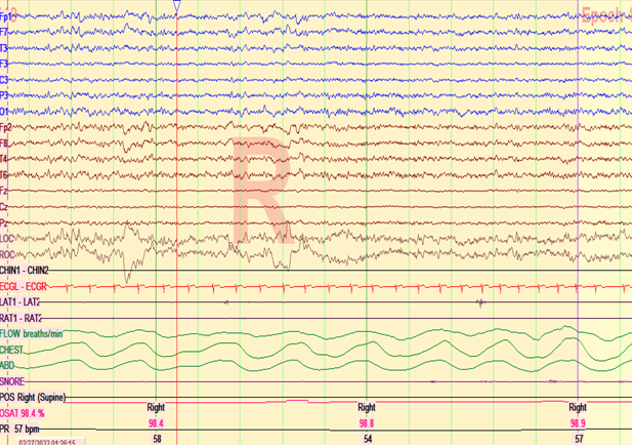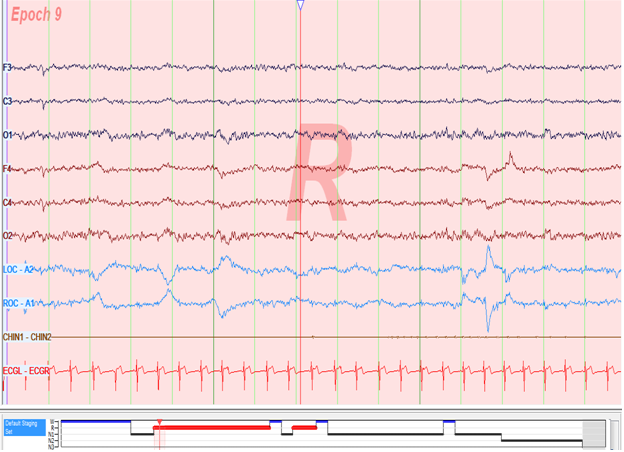- Visibility 366 Views
- Downloads 48 Downloads
- Permissions
- DOI 10.18231/j.ijn.2022.056
-
CrossMark
- Citation
Syncope masquerading narcolepsy- An unusual presentation
Abstract
Narcolepsy is a rare disorder of sleep wake cycle which can result in persistent excessive day time sleepiness. It is due to the deficiency of the Orexin/Hypocretin in the body. Most of these cases are reported in young adults and are difficult to diagnose early. This can lead to serious impairments in social and occupational settings if not promptly treated. Thus we are reporting an interesting case of a teenager who presented with falls. He was diagnosed with nocturnal Polysomnography followed by Multiple Sleep Latency Test (MSLT), and he significantly benefitted from treatment with Modafinil.
Introduction
Narcolepsy can cause chronic sleepiness. In addition to this, most of the patients experience cataplexy, sleep paralysis and hypnagogic hallucinations.[1] About half of the patients with narcolepsy do not have cataplexy and this type is less severe.[2] Narcolepsy is under diagnosed in Indian settings.[3] In most people, symptoms start between the ages of 10 and 35 years. Narcolepsy can have serious psychosocial impairment if not diagnosed and treated early. [4]
Clinical Presentation
Sixteen year old boy presented with history of recurrent falls since Ten years of age. While sitting in class, especially during height of emotions like laughing or while upset he was noted to experience transient sudden loss of consciousness. In view of this, he was evaluated for reflex syncope versus seizures. EEG and MRI brain were normal. Cardiac evaluation including ECG and ECHO were also normal. He underwent extensive evaluation for loss of consciousness and fall, but all investigations were within normal limits. He said that was he was unable to move immediately after awakening from sleep although he was fully aware of everything happening around him. He began seeing and hearing things that were not real or visible to others. This led to the treating physician to think that the symptoms could be psychogenic. Hence, he was taken to a psychiatrist and underwent counseling sessions but there was no benefit.
He was finally referred to our Neuroscience team. Detailed history revealed that, other than the falls, he also seemed to be sleeping in class. The parents also said that he slept more as compared to his siblings. There was history of falling asleep frequently in classrooms and while talking to others. He also gave history of being unable to move for few minutes after laughing for some time. He seemed to doze off at inappropriate times. He also gave history of abrupt jerky movement of limbs during sleep. This led to the suspicion of a sleep related disorder.
On examination, the patient was a moderately built teenager, active and cheerful. Detailed neurological examination did not reveal any focal neurological deficits. A detailed sleep history was taken, and excessive day time sleepiness was assessed using Epworth Sleepiness Scale (ESS) score. His ESS score was twenty. After reviewing the brain images and other investigations which were within normal limits, it was decided to go ahead with a nocturnal video assisted Polysomnography (PSG) study. In addition to the standard PSG electrodes, we connected extended EEG electrodes to detect epileptic abnormalities ([Figure 1]). PSG showed normal respiratory and EEG parameters, but REM stage onset was around four minutes. In view of the normal PSG study with early onset REM; Multiple Sleep Latency Test (MSLT) was done on the next day. Standard MSLT electrodes were connected and a total of five naps were recorded ([Figure 2]). Mean sleep onset latency was found to be 5.4 minutes and two Sleep onset REM periods (SOREMP) were recorded. These findings are diagnostic of narcolepsy.


Discussion
Narcolepsy is caused due to the deficiency of Orexin A and B (Hypocretin 1 and 2) which was discovered independently by two different scientists. Orexins play a significant role in maintaining wakefulness. [1] Narcolepsy with cataplexy is due very low Orexin levels or it’s signaling. [4] HLA DQB1*0602 is found in most of the patients with narcolepsy. [5] Narcolepsy may not always present with the typical triad of symptoms. Canellas et al reported a case series of Narcolepsy patients with psychosis and schizophrenia which posed a diagnostic challenge. [6] Although narcolepsy is most commonly reported in young adults, extreme age groups are also rarely reported. [7] Unusual presentation of narcolepsy is not uncommon. Zhou et al reported narcolepsy in a patient as young as a six year old child who was initially diagnosed as atypical epilepsy which is similar to our case report. [8] Ray et al in India studied four cases of narcolepsy over a period of 4 years. They concluded that narcolepsy occurs rarely in India and predominantly in males in their thirties. [7] Gupta et al also reported a case of Narcolepsy from India which was diagnosed with MSLT. [9] A high index of suspicion is needed to diagnose this condition.
There have been only rare case reports of Narcolepsy diagnosed with MSLT from India. This patient was diagnosed after a detailed history, PSG and MSLT testing. On further testing, he was also found to have HLA alleles associated with Narcolepsy. He responded very well to Modafinil. The patient is under follow up with our team.
Conflicts of Interest
All contributing authors declare no conflicts of interest.
Source of Funding
None.
References
- Burgess C, Scammell T. Narcolepsy: neural mechanisms of sleepiness and cataplexy. J Neurosci. 2012;32(36):12305-11. [Google Scholar] [Crossref]
- Vellieux G, Frija-Masson J, Rouvel-Tallec A, Drouot X, Ortho M. Narcolepsy Type 1: A Remitting Disease? An Unusual Case Report. Nat Sci Sleep. 2021;13:1669-73. [Google Scholar] [Crossref]
- SS, Muniem A, MB. Diagnosis and management of narcolepsy in the Indian scenario. Ann Indian Acad Neurol. 2016;19(4):456-61. [Google Scholar]
- Barker E, Flygare J, Paruthi S, Sharkey K. Living with Narcolepsy: Current Management Strategies, Future Prospects, and Overlooked Real-Life Concerns. Nat Sci Sleep. 2020;12:453-66. [Google Scholar] [Crossref]
- Krahn L, Zee P, Thorpy M. Current Understanding of Narcolepsy 1 and its Comorbidities: What Clinicians Need to Know. Adv Ther. 2022;39(1):221-43. [Google Scholar] [Crossref]
- Canellas-Dols F, Delgado C, Arango-Lopez C, Peraita-Adrados R. Narcolepsy-cataplexy, and psychosis: a case study. Rev Neurol. 2017;65(2):70-4. [Google Scholar]
- Zhou J, Zhang X, Dong Z. Case report of narcolepsy in a six-year-old child initially misdiagnosed as atypical epilepsy. Shanghai Arch Psychiatry. 2014;26(4):232-5. [Google Scholar] [Crossref]
- Ray A, Kanabar K, Upadhyay V, Sharma S. A four-year experience in narcolepsy from a sleep clinic at a tertiary care centre with a short review of contemporary Indian literature. Indian J Med Res. 2018;148(6):748-51. [Google Scholar]
- Gupta R, Goel D, Farney R, Walker J. Narcolepsy: A case from India with polysomnographic findings. Neurol India. 2012;60(1):79-81. [Google Scholar] [Crossref]
How to Cite This Article
Vancouver
Parameswaran S, Sankarapillai P, Mohan A, V AKT, M AG, Pillai AM. Syncope masquerading narcolepsy- An unusual presentation [Internet]. IP Indian J Neurosci. 2022 [cited 2025 Oct 09];8(4):286-288. Available from: https://doi.org/10.18231/j.ijn.2022.056
APA
Parameswaran, S., Sankarapillai, P., Mohan, A., V, A. K. T., M, A. G., Pillai, A. M. (2022). Syncope masquerading narcolepsy- An unusual presentation. IP Indian J Neurosci, 8(4), 286-288. https://doi.org/10.18231/j.ijn.2022.056
MLA
Parameswaran, Sajeesh, Sankarapillai, Ponnu, Mohan, Ajith, V, Anil Kumar T, M, Aswin Ganesh, Pillai, A Marthanda. "Syncope masquerading narcolepsy- An unusual presentation." IP Indian J Neurosci, vol. 8, no. 4, 2022, pp. 286-288. https://doi.org/10.18231/j.ijn.2022.056
Chicago
Parameswaran, S., Sankarapillai, P., Mohan, A., V, A. K. T., M, A. G., Pillai, A. M.. "Syncope masquerading narcolepsy- An unusual presentation." IP Indian J Neurosci 8, no. 4 (2022): 286-288. https://doi.org/10.18231/j.ijn.2022.056
